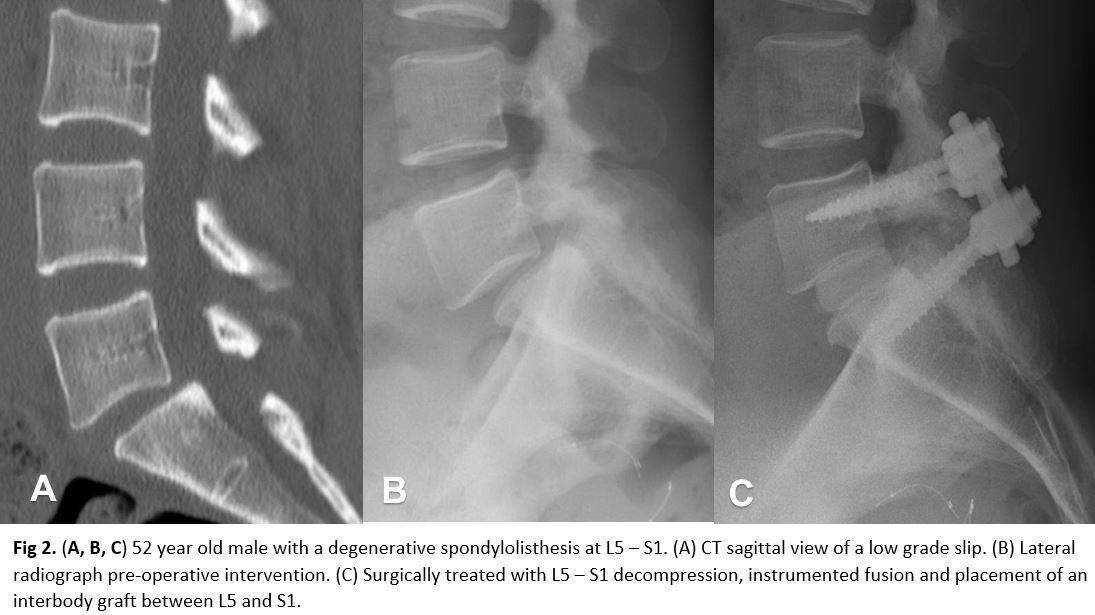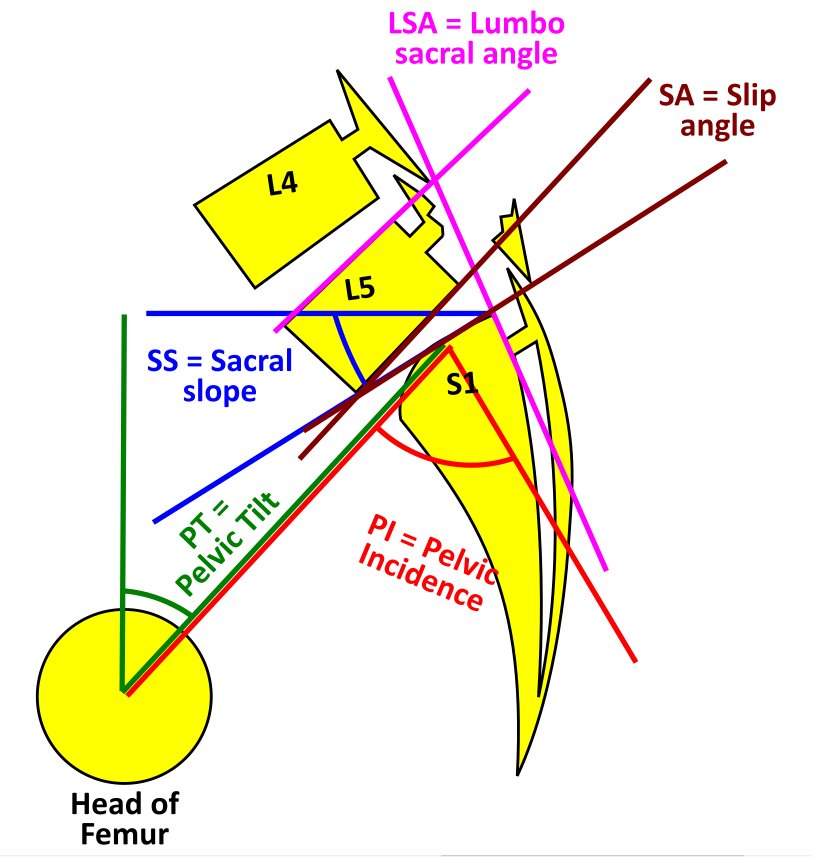[1]
Cavalier R, Herman MJ, Cheung EV, Pizzutillo PD. Spondylolysis and spondylolisthesis in children and adolescents: I. Diagnosis, natural history, and nonsurgical management. The Journal of the American Academy of Orthopaedic Surgeons. 2006 Jul:14(7):417-24
[PubMed PMID: 16822889]
[2]
Foreman P, Griessenauer CJ, Watanabe K, Conklin M, Shoja MM, Rozzelle CJ, Loukas M, Tubbs RS. L5 spondylolysis/spondylolisthesis: a comprehensive review with an anatomic focus. Child's nervous system : ChNS : official journal of the International Society for Pediatric Neurosurgery. 2013 Feb:29(2):209-16. doi: 10.1007/s00381-012-1942-2. Epub 2012 Oct 23
[PubMed PMID: 23089935]
[3]
Cheung EV, Herman MJ, Cavalier R, Pizzutillo PD. Spondylolysis and spondylolisthesis in children and adolescents: II. Surgical management. The Journal of the American Academy of Orthopaedic Surgeons. 2006 Aug:14(8):488-98
[PubMed PMID: 16885480]
[4]
Herman MJ, Pizzutillo PD, Cavalier R. Spondylolysis and spondylolisthesis in the child and adolescent athlete. The Orthopedic clinics of North America. 2003 Jul:34(3):461-7, vii
[PubMed PMID: 12974495]
[5]
Jones TR, Rao RD. Adult isthmic spondylolisthesis. The Journal of the American Academy of Orthopaedic Surgeons. 2009 Oct:17(10):609-17
[PubMed PMID: 19794218]
[6]
Eismont FJ, Norton RP, Hirsch BP. Surgical management of lumbar degenerative spondylolisthesis. The Journal of the American Academy of Orthopaedic Surgeons. 2014 Apr:22(4):203-13. doi: 10.5435/JAAOS-22-04-203. Epub
[PubMed PMID: 24668350]
[7]
Ibebuike K, Roussot M, Watt J, Dunn R. Management challenges of traumatic spondylolisthesis of the Axis with an unusual C2-C3 posterior subluxation in a paediatric patient: case report and literature review. African health sciences. 2018 Jun:18(2):458-467. doi: 10.4314/ahs.v18i2.31. Epub
[PubMed PMID: 30602973]
Level 3 (low-level) evidence
[8]
Boxall D, Bradford DS, Winter RB, Moe JH. Management of severe spondylolisthesis in children and adolescents. The Journal of bone and joint surgery. American volume. 1979 Jun:61(4):479-95
[PubMed PMID: 438234]
[9]
Saraste H. Long-term clinical and radiological follow-up of spondylolysis and spondylolisthesis. Journal of pediatric orthopedics. 1987 Nov-Dec:7(6):631-8
[PubMed PMID: 2963019]
[10]
Kalichman L, Kim DH, Li L, Guermazi A, Berkin V, Hunter DJ. Spondylolysis and spondylolisthesis: prevalence and association with low back pain in the adult community-based population. Spine. 2009 Jan 15:34(2):199-205. doi: 10.1097/BRS.0b013e31818edcfd. Epub
[PubMed PMID: 19139672]
[11]
Omidi-Kashani F, Ebrahimzadeh MH, Salari S. Lumbar spondylolysis and spondylolytic spondylolisthesis: who should be have surgery? An algorithmic approach. Asian spine journal. 2014 Dec:8(6):856-63. doi: 10.4184/asj.2014.8.6.856. Epub 2014 Dec 17
[PubMed PMID: 25558333]
[12]
Bouras T, Korovessis P. Management of spondylolysis and low-grade spondylolisthesis in fine athletes. A comprehensive review. European journal of orthopaedic surgery & traumatology : orthopedie traumatologie. 2015 Jul:25 Suppl 1():S167-75. doi: 10.1007/s00590-014-1560-7. Epub 2014 Nov 14
[PubMed PMID: 25394940]
[13]
Schulte TL, Ringel F, Quante M, Eicker SO, Muche-Borowski C, Kothe R. Surgery for adult spondylolisthesis: a systematic review of the evidence. European spine journal : official publication of the European Spine Society, the European Spinal Deformity Society, and the European Section of the Cervical Spine Research Society. 2016 Aug:25(8):2359-67. doi: 10.1007/s00586-015-4177-6. Epub 2015 Sep 12
[PubMed PMID: 26363561]
Level 1 (high-level) evidence
[14]
Shah SA, Saller J. Evaluation and Diagnosis of Back Pain in Children and Adolescents. The Journal of the American Academy of Orthopaedic Surgeons. 2016 Jan:24(1):37-45. doi: 10.5435/JAAOS-D-14-00130. Epub
[PubMed PMID: 26589458]
[15]
Syrmou E, Tsitsopoulos PP, Marinopoulos D, Tsonidis C, Anagnostopoulos I, Tsitsopoulos PD. Spondylolysis: a review and reappraisal. Hippokratia. 2010 Jan:14(1):17-21
[PubMed PMID: 20411054]
[16]
Scaia V, Baxter D, Cook C. The pain provocation-based straight leg raise test for diagnosis of lumbar disc herniation, lumbar radiculopathy, and/or sciatica: a systematic review of clinical utility. Journal of back and musculoskeletal rehabilitation. 2012:25(4):215-23. doi: 10.3233/BMR-2012-0339. Epub
[PubMed PMID: 23220802]
Level 1 (high-level) evidence
[17]
Miyamoto N, Hirata K, Kimura N, Miyamoto-Mikami E. Contributions of Hamstring Stiffness to Straight-Leg-Raise and Sit-and-Reach Test Scores. International journal of sports medicine. 2018 Feb:39(2):110-114. doi: 10.1055/s-0043-117411. Epub 2017 Nov 30
[PubMed PMID: 29190853]
[18]
Chen X, Zhou QS, Xu L, Chen ZH, Zhu ZZ, Li S, Qiu Y, Sun X. Does kyphotic configuration on upright lateral radiograph correlate with instability in patients with degenerative lumbar spondylolisthesis? Clinical neurology and neurosurgery. 2018 Oct:173():96-100. doi: 10.1016/j.clineuro.2018.07.020. Epub 2018 Jul 30
[PubMed PMID: 30096570]
Level 2 (mid-level) evidence
[19]
Harris IE, Weinstein SL. Long-term follow-up of patients with grade-III and IV spondylolisthesis. Treatment with and without posterior fusion. The Journal of bone and joint surgery. American volume. 1987 Sep:69(7):960-9
[PubMed PMID: 3654708]
[20]
Mishra A, Agrawal D, Gupta D, Sinha S, Satyarthee GD, Singh PK. Traumatic spondyloptosis: a series of 20 patients. Journal of neurosurgery. Spine. 2015 Jun:22(6):647-52. doi: 10.3171/2014.10.SPINE1440. Epub 2015 Mar 13
[PubMed PMID: 25768668]
[21]
Evans N, McCarthy M. Management of symptomatic degenerative low-grade lumbar spondylolisthesis. EFORT open reviews. 2018 Dec:3(12):620-631. doi: 10.1302/2058-5241.3.180020. Epub 2018 Dec 19
[PubMed PMID: 30697442]
[22]
Klein G, Mehlman CT, McCarty M. Nonoperative treatment of spondylolysis and grade I spondylolisthesis in children and young adults: a meta-analysis of observational studies. Journal of pediatric orthopedics. 2009 Mar:29(2):146-56. doi: 10.1097/BPO.0b013e3181977fc5. Epub
[PubMed PMID: 19352240]
Level 1 (high-level) evidence
[23]
Donnally CJ 3rd, Rush AJ 3rd, Rivera S, Vakharia RM, Vakharia AM, Massel DH, Eismont FJ. An epidural steroid injection in the 6 months preceding a lumbar decompression without fusion predisposes patients to post-operative infections. Journal of spine surgery (Hong Kong). 2018 Sep:4(3):529-533. doi: 10.21037/jss.2018.09.05. Epub
[PubMed PMID: 30547115]
[24]
Ilyas H, Udo-Inyang I Jr, Savage J. Lumbar Spinal Stenosis and Degenerative Spondylolisthesis: A Review of the SPORT Literature. Clinical spine surgery. 2019 Aug:32(7):272-278. doi: 10.1097/BSD.0000000000000841. Epub
[PubMed PMID: 31145150]
[25]
Donnally CJ 3rd, Madhavan K, Butler AJ, Sheu JI, Massel DH, Green BA, Gjolaj JP. A novel technique for stabilization of high-grade spondylolisthesis with transvertebral fusion without reduction. Journal of clinical neuroscience : official journal of the Neurosurgical Society of Australasia. 2019 Feb:60():170-175. doi: 10.1016/j.jocn.2018.11.001. Epub 2018 Nov 22
[PubMed PMID: 30470650]
[26]
Shenoy K, Stekas N, Donnally CJ 3rd, Zhao W, Kim YH, Lurie JD, Razi AE. Retrolisthesis and lumbar disc herniation: a postoperative assessment of outcomes at 8-year follow-up. The spine journal : official journal of the North American Spine Society. 2019 Jun:19(6):995-1000. doi: 10.1016/j.spinee.2018.12.010. Epub 2018 Dec 27
[PubMed PMID: 30594668]
[28]
Austevoll IM, Gjestad R, Solberg T, Storheim K, Brox JI, Hermansen E, Rekeland F, Indrekvam K, Hellum C. Comparative Effectiveness of Microdecompression Alone vs Decompression Plus Instrumented Fusion in Lumbar Degenerative Spondylolisthesis. JAMA network open. 2020 Sep 1:3(9):e2015015. doi: 10.1001/jamanetworkopen.2020.15015. Epub 2020 Sep 1
[PubMed PMID: 32910195]
Level 2 (mid-level) evidence


